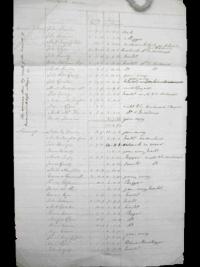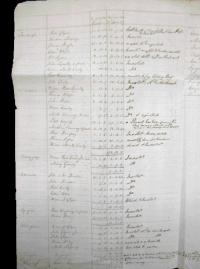Pray pity your poor people . . the Mahon papers and the famine of 1822 in the west
Published in 18th-19th Century Social Perspectives, 18th–19th - Century History, Features, Issue 5 (Sept/Oct 2011), Volume 19
The humble petition of the poor tenants of Clooncanon to their landlord’. (National Library of Ireland)
Sometime in the mid-1820s tenants on the Mahon estate at Ahascragh in north County Galway wrote to their landlord, begging him not to evict them:
‘Pray pity your poor people who always did and always will pay their rents well, better drown us than turn us off, for there is no place for us anywhere. We were a quiet easy poor people who did never complain . . . why would you destroy us . . .’
The partial failure of the potato crop in 1821 precipitated the crisis and represented the most serious period of food shortage in the early nineteenth century, with extreme distress occurring in nine western counties from late April until mid-August 1822, resulting in deaths from starvation in the extreme west and deaths from typhus across many parts of the countryside and in many towns. The government estimated that the inability of the rural poor to purchase food in counties Cork, Kerry, Limerick, Clare, Galway, Roscommon, Sligo, Leitrim and Mayo resulted in over one million people living on the verge of starvation in the month of July alone.

Ross Mahon’s list of 71 destitute tenants owing arrears of £515–9s.–2?d.—two heads of families are listed as ‘dead’, ten families listed as ‘beggars’, nineteen listed as ‘insolvent’, 21 ‘to be discharged’ and eleven families are ominously labelled ‘gone away’. (National Library of Ireland)
The Irish rural population began to increase at a phenomenal rate during the last two decades of the eighteenth century, with the preference for early marriages and the dominant position of the potato sustaining a culture of large family units, reinforced by the cheapness of rearing children and their value as free labour. The inherent tendency towards the subletting of already inadequate plots, aggravated by the increasing preference of landowners to sublet large sections of their estates, the absence of a Poor Law until 1838 and the concurrent necessity for several generations to live together in cramped cabins, which were often shared with the family’s cow or pig, contributed to the often wretched lives of the typical rural family in the west.Historian Samuel Clark has observed that during this period landowners were especially anxious to dislodge poverty-stricken squatters who occupied land without official permission and frequently without paying rent. With eviction clearly in mind on the Ahascragh portion of his estate, in 1823 Ross Mahon compiled a return of 71 destitute tenants owing arrears of £515–9s.–2?d. The 1823 Mahon rentals highlight the devastation that the 1822 famine brought to one small community, with two heads of families listed as ‘dead’, ten families listed as ‘beggars’, nineteen listed as ‘insolvent’, 21 listed as ‘to be discharged’ and eleven families ominously labelled ‘gone away’.
 The townland of Lunaghton had arrears of £56 owed by a large group of tenants for potato ground, representing the combined debts of a significant group of landless cottiers and small tenants.A similar pattern of debt emerges on the Roscommon portion of the estate, where Mahon’s land agent had previously categorised 22 tenants as ‘good’, five as ‘middling’ and ten as ‘indifferent’, with only nine tenants listed as ‘bad’. Nevertheless, despite only ten tenants being listed as ‘bad’, Mahon served eviction notices on all 55 Roscommon tenants, along with fourteen subtenants, in October 1825.The Mahon rentals of 1823 highlight the extreme vulnerability of the rural poor to regular episodes of food shortage in the early nineteenth century and the precariousness of their foothold on the land. The rentals are available to download on-line on the National Library of Ireland’s Flickr site, along with all the documents featured in this series. The entire catalogue for the Mahon estate papers is available to download on the manuscript section of the National Library of Ireland’s website. HI
The townland of Lunaghton had arrears of £56 owed by a large group of tenants for potato ground, representing the combined debts of a significant group of landless cottiers and small tenants.A similar pattern of debt emerges on the Roscommon portion of the estate, where Mahon’s land agent had previously categorised 22 tenants as ‘good’, five as ‘middling’ and ten as ‘indifferent’, with only nine tenants listed as ‘bad’. Nevertheless, despite only ten tenants being listed as ‘bad’, Mahon served eviction notices on all 55 Roscommon tenants, along with fourteen subtenants, in October 1825.The Mahon rentals of 1823 highlight the extreme vulnerability of the rural poor to regular episodes of food shortage in the early nineteenth century and the precariousness of their foothold on the land. The rentals are available to download on-line on the National Library of Ireland’s Flickr site, along with all the documents featured in this series. The entire catalogue for the Mahon estate papers is available to download on the manuscript section of the National Library of Ireland’s website. HI















